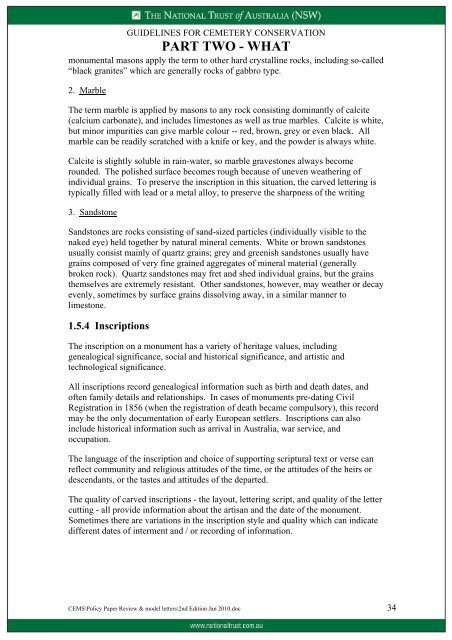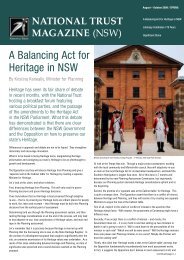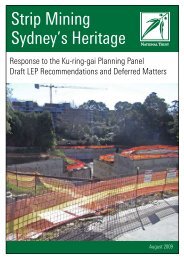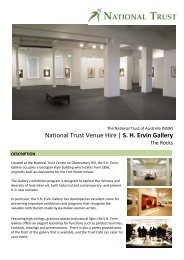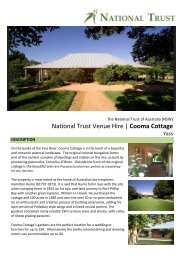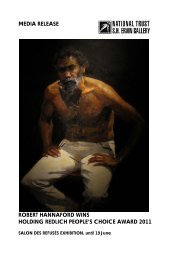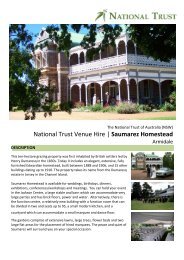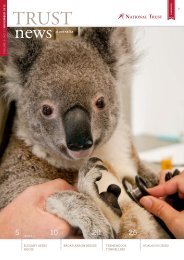Guidelines for Cemetery Conservation - National Trust of Australia
Guidelines for Cemetery Conservation - National Trust of Australia
Guidelines for Cemetery Conservation - National Trust of Australia
You also want an ePaper? Increase the reach of your titles
YUMPU automatically turns print PDFs into web optimized ePapers that Google loves.
GUIDELINES FOR CEMETERY CONSERVATION<br />
PART TWO - WHAT<br />
monumental masons apply the term to other hard crystalline rocks, including so-called<br />
“black granites” which are generally rocks <strong>of</strong> gabbro type.<br />
2. Marble<br />
The term marble is applied by masons to any rock consisting dominantly <strong>of</strong> calcite<br />
(calcium carbonate), and includes limestones as well as true marbles. Calcite is white,<br />
but minor impurities can give marble colour -- red, brown, grey or even black. All<br />
marble can be readily scratched with a knife or key, and the powder is always white.<br />
Calcite is slightly soluble in rain-water, so marble gravestones always become<br />
rounded. The polished surface becomes rough because <strong>of</strong> uneven weathering <strong>of</strong><br />
individual grains. To preserve the inscription in this situation, the carved lettering is<br />
typically filled with lead or a metal alloy, to preserve the sharpness <strong>of</strong> the writing<br />
3. Sandstone<br />
Sandstones are rocks consisting <strong>of</strong> sand-sized particles (individually visible to the<br />
naked eye) held together by natural mineral cements. White or brown sandstones<br />
usually consist mainly <strong>of</strong> quartz grains; grey and greenish sandstones usually have<br />
grains composed <strong>of</strong> very fine grained aggregates <strong>of</strong> mineral material (generally<br />
broken rock). Quartz sandstones may fret and shed individual grains, but the grains<br />
themselves are extremely resistant. Other sandstones, however, may weather or decay<br />
evenly, sometimes by surface grains dissolving away, in a similar manner to<br />
limestone.<br />
1.5.4 Inscriptions<br />
The inscription on a monument has a variety <strong>of</strong> heritage values, including<br />
genealogical significance, social and historical significance, and artistic and<br />
technological significance.<br />
All inscriptions record genealogical in<strong>for</strong>mation such as birth and death dates, and<br />
<strong>of</strong>ten family details and relationships. In cases <strong>of</strong> monuments pre-dating Civil<br />
Registration in 1856 (when the registration <strong>of</strong> death became compulsory), this record<br />
may be the only documentation <strong>of</strong> early European settlers. Inscriptions can also<br />
include historical in<strong>for</strong>mation such as arrival in <strong>Australia</strong>, war service, and<br />
occupation.<br />
The language <strong>of</strong> the inscription and choice <strong>of</strong> supporting scriptural text or verse can<br />
reflect community and religious attitudes <strong>of</strong> the time, or the attitudes <strong>of</strong> the heirs or<br />
descendants, or the tastes and attitudes <strong>of</strong> the departed.<br />
The quality <strong>of</strong> carved inscriptions - the layout, lettering script, and quality <strong>of</strong> the letter<br />
cutting - all provide in<strong>for</strong>mation about the artisan and the date <strong>of</strong> the monument.<br />
Sometimes there are variations in the inscription style and quality which can indicate<br />
different dates <strong>of</strong> interment and / or recording <strong>of</strong> in<strong>for</strong>mation.<br />
CEMS\Policy Paper Review & model letters\2nd Edition Jan 2010.doc 34


